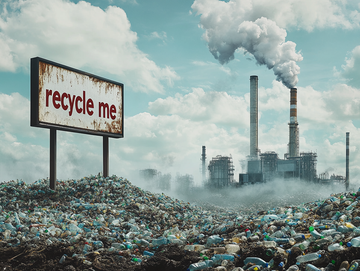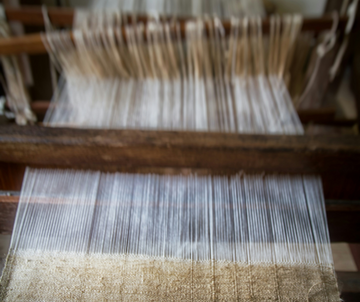Recycling is making its way into our drawers and into the communications of all brands. How can we interpret this trend?
In our December 2024 survey, 53% of you cited the use of recycled materials as a sign of sustainable practices.
For a few years now I have learned 2 or 3 things about recycling that I wanted to share with you:
- The difference between pre-consumer and post-consumer is fundamental when we talk about recycling.
- The production of recycled fibers has a lower socio-environmental impact than the production of virgin fibers, but the gap is not as high as one might think
- Recycled synthetic fibers draw on resources from other sectors (plastic bottles among others) which only shifts the problem of plastic production on Earth...
Foreword: Far be it from us to distribute good and bad points, transparency and the sharing of information are principles that drive our approach, so we hope that the following elements will allow you to sort through, make informed choices and favor brands that allow you to do so.
It is estimated that 60% of recycled polyester used in textiles is actually “pre-consumer” and that only 15% of the polyester produced annually is recycled
Recycling yes, but pre- or post-consumer?
- Post-consumer recycled fibers are those fibers that have been extracted from waste that has had at least one life, for example, the plastic bottle that we throw in the yellow bin and which is recycled to make yarn.
-
Pre-consumer recycled , on the other hand, comes from waste generated during a production process (material scraps or production surpluses). This waste can be injected into textile fiber production and produce Polyester which can be called… recycled - but it is neither more nor less than the optimization of industrial processes and it is nothing new.
It is estimated that 60% of recycled polyester used in textiles is actually “pre-consumer” and that only 15% of the polyester produced annually is recycled (source: Textile Exchange “Preferred Fiber & Materials Market report 2022”).
In the case of “post-consumer”, if we want to use it in textiles it is impossible to do it as is: in general, virgin fibers are added (which constitute up to 30 or 40% of the yarn obtained) in order to achieve the whiteness and quality required by the brands.
To our knowledge, only one brand of cycling clothing is transparent about this by indicating on the description of its product pages the % of pre- and post-consumer which compose its recycled fabrics, this is the English company Universal Colours.
Conclusion : If you have read this far, you understand that it is much more commercially effective to write “T-shirt made from recycled polyester” rather than taking the time to explain what recycled is, or even to indicate that it is pre-consumer recycled.
Confession : We were surprised by the lack of knowledge of many fabric manufacturers who sell recycled materials: when we ask them whether it is pre- or post-consumer, they don't always know and even their yarn suppliers sometimes have difficulty answering us.
Is recycled better for the planet than virgin fibers?
The carbon impact savings of recycled material are estimated at 13% compared to its virgin cousin
NB: we are talking here exclusively about synthetic fibers (which represent around 60% of the textile fibers produced in the world each year, far ahead of the others) and in particular polyester which is one of the main fibers used in the manufacture of technical clothing (including cycling clothing).
Synthetic fibers are products of the oil industry, accounting for 1% of annual global production.
Recycling polyester at least avoids the stages of extraction and refining of oil, however, according to a very comprehensive article written by Loom on his blog “la mode à l'envers” the carbon impact savings of a recycled product are estimated at 13% compared to its virgin cousin, that's already something but it's far from miraculous!
Why ?
- the raw material constitutes between 30% and 40% of the carbon impact of a garment (20 to 30% for its manufacture, 10% its transport, 20 to 30% its use and 5 to 10% its end of life) but for a garment made from recycled polyester, we “only” save on the raw material
- nearly 55% of recycled polyester is produced in China and India, whose energy mixes are dominated by coal (Europe accounts for 20 to 25% of the production of recycled polyester yarns): thus the production of 1 kWh in China emits 0.76 kg of CO2, 0.85 in India compared to 0.06 in France (source ADEME)!
99% of post-consumer recycled material comes from... plastic bottles!
50 million plastic bottles are recycled each year for textile production.
Recycling polyester is good, but when it comes to textiles, we are far from the circular economy since we use used bottles or scraps at their place of production to make clothes when they should be recycled... into bottles (which incidentally would allow them to be recycled a large number of times, while it is impossible to reinject the fibers of a recycled polyester garment into the circuit, the fibers being often mixed with others (notably elastane), which makes their mechanical separation extremely complex and therefore almost impossible, to date, to make new jerseys with old ones.
It is therefore necessary to produce more plastic in any case to compensate for the approximately 50 million plastic bottles recycled each year for textile production.
For those who want to delve deeper into the subject and explore the innovations that would allow us to achieve the “textile-to-textile” goldilocks, which are still out of reach to date, we recommend this article .
In conclusion , the key is to reduce your consumption and buy clothes that you care about and that last - in fact, 81% of you told us that the longevity of products was the key to a more sustainable practice.
It's hard not to agree with you!




